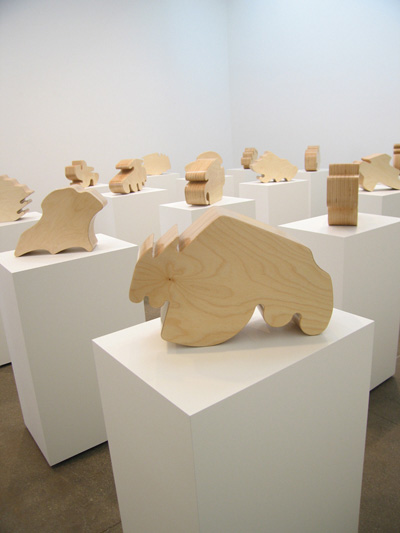 Allan McCollum's show "The Shapes Project" was at Friedrich Petzel Gallery in New York [Nov 3-Dec 23, 2006] and at Galerie Thomas Schulte in Berlin [Sept. 29-Nov 11, 2006]. |
|
Shape Shifter |
|
Allan McCollum's new "Shapes Project" |
|
NANCY PRINCENTHAL
|
|
The take-home message of Allan McCollum's latest endeavor is that there's nothing more common than being unique—everyone on the planet is. In his only partly hypothetical Shapes Project, McCollum has devised a plan to generate a distinctive shape for everyone alive, and then some. The program is fiendishly complex and fundamentally hand-made. Using his home computer and Adobe Illustrator, McCollum mixes and matches 300 abstract "features," bounded by a range of curving and stepped contours, and puzzles them together in groups of four to six to create each shape. Designing the features, whose differences must be small but readily discernible, was the trickiest part of the project, and led McCollum to a variety of resources, from the capabilities of computer graphics to the formal vocabulary of Myron Stout. Mind-boggingly, the Shapes Project is conceived to generate 31 billion different shapes (enough to comfortably accommodate world population at its expected peak in 2050, estimated at anywhere between 8 billion and 20 billion people); to date, 214,000,000 have been "set aside for creative experimentation," McCollum says in an artist's statement. In addition to art, he envisions "gifts, awards, identity markers, emblems, insignia, logos, toys, souvenirs, education tools and so forth." Standard graphics software and rapid prototyping machines could produce these applications.
As always with McCollum's work, the Petzel installation was impeccably elegant and slightly sinister. Roughly a foot-and-a-half across and over 5 inches deep, the heavily lacquered birch plywood shapes have likable cartoony swerves—in scale and form, they suggest portrait busts for some friendly, if alien, race. And since the pedestals were tightly ranked, walking among them was a lot like negotiating a social gathering, confronting first one and then another generically different pale wooden face. On the other hand, the impenetrably dense crowd of small (51/2-by-41/4-inch) black silhouettes on the vertiginously receding bleachers felt positively malign. Row upon tightly packed, infinitely seeming row of evilly glinting, glass-fronted and black-bordered shapes glared at the viewer, each distinct (though they are produced, and sold, in batches of 144), all united in their baleful regard. Farfetched though it may seem, the anthropomorphizing is, of course, McCollum's intention. The information in the binders only reinforces the project's creepy-crowd totalitarianism: the digital mind, McCollum seems to say, has your number.
McCollum has been investigating the problem of the copy with the paradoxical originality for nearly 30 years. He began the blank-faced Surrogate Paintings in 1978, first fabricating each by hand and then, in prodigious numbers, as plaster casts. They quickly established a benchmark for challenging the marketplace by simulating its sheer productivity, though McCollum has also talked about them as implicit portraits, with striking relevance to the Shapes Project. Fossils and casts—of, among other things, dinosaur bones and footprints, and a dog buried alive at Pompeii—followed over the years. Over Ten Thousand Individual Works (1987-88), which consists of the said quantity of mysterious but familiar-looking palm-sized objects, assembled from bits of everyday tools and accessories that are presented as same-color casts on enormous tables, also involved several elements that appear in the Shapes Project. In Helen Molesworth's terms, they are an expression of "the reciprocity between bodies and things," and the notion that as individual beings we have been "rendered equivalent to one another—we are interchangeable."1
Catnip for critics, McCollum's work presents a wealth of conceptual treats that tend to conceal surprising nuggets of melancholy. Writing about the cast-plaster Surrogate Paintings in these pages in 1983, Craig Owens discussed the work as a critique of consumerism, quoting Baudrillard to the effect that in the marketplace of the 20th century, "difference itself becomes apparent: to carefully engineer and control the production of difference in our society." It was a description thoroughly consistent with McCollum's motivation at the time. But Owens began and ended in a different register, quoting Deleuze first on repetition as a means to "make a sport of death," and then on seriality as "liberating the forces needed to destroy this world."3 Several years later McCollum told Lynne Cooke, "It is probably evident in my work that I suffer some preoccupation with absence, and with death."4 And soon after, in 1992, he told Thomas Lawson, "To the degree to which we're enmeshed in relationships with our own copies in the world, we are constantly in a state of banishment from the imaginary 'source' of things. . . . So copies are always about something that's absent, and in that way they carry a sense of mourning, death, or loss."5 If bracing humor is the predominant emotional tone of the Shapes Project (along with a horror vacui that has been part of McCollum's artistic character from the start), the project is also a frank exploration of mortality—indeed, so breezily candid that it's easy to miss it's depth. To read the artist's introduction |
|
1. Helen Molesworth, "Allan McCollum," in Molesworth, Part Object, Part Sculpture, Columbus, Wexner Center for the Arts, 2005, p. 203. 2. "Allan McCollum Interviewed by Thomas Lawson," in William Bartman, ed., Allan McCollum, Los Angeles, A.R.T. Press, 1996. p. 21. 3. Craig Owens, "Allan McCollum: Repetition & Difference," Art in America, September 1983, pp. 130-32. 4. Lynne Cooke, " Interview with Allan McCollum," Carnegie International 1991, Pittsburgh, Carnegie Museum of Art, 1991, Vol. 1, p. 100. 5."Allan McCollum Interviewed by Thomas Lawson," p. 3. |


